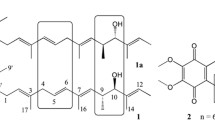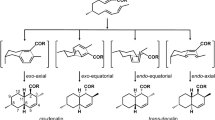Abstract
A versatile fungus isolated in our laboratory and identified asMucor piriformis has been shown to effect novel and preparatively useful transformations in steroids and morphine alkaloids. The organism very effectively carries out hydroxylation of various C19 and C21 steroids at 7 and 14-positions. Although the organism is capable of catalysing hydroxylation at 6β and 1lα-positions, these are not the major activities. The 14α-hydroxylase appears to have a broad substrate specificity. However, steroids with a bulky substitution at C-17 α-position or without the 4-en-3-one group are not accepted as substrates by the 14α-hydroxylase system. Studies have demonstrated how various C19 and C21 steroids can be modified to yield new structures which are either difficult to prepare by traditional methods or hitherto unknown. The organism also very efficiently and selectively carries out the N-dealkylation of thebaine and its N-variants. Interestingly, the nor-compound formed does not get further metabolized. Since thebaine is very often used as a starting material to synthesize various morphine agonists as well as antagonists, and one of the steps involved in their preparation is the N-dealkylation reaction, the microbial process could certainly offer an alternative approach.
Similar content being viewed by others
References
Bell A M, Jones Sir E R H, Meakin G D, Miners J O and Wilkins A L1975J. Chem. Soc., Perkin I 2040
Capek A, Hanc O and Pavlu H 1957Cesk. Microbiol. 2 168
Charney W and Herzog H L 1967 InMicrobiol. transformations of steroids: A handbook (New York: Academic Press)
Crabb T A, Dawson P J and Williams R O 1980J. Chem. Soc. Perkin I 2535
Crout D H G and Christen M 1989 InBiotransformations in organic synthesis (ed.) R. Schefold (Berlin: Springer) pp. 1–114
Davies H G, Green R H, Kelly D R and Roberts S M 1989 InBiotransformations in preparative organic chemistry. The use of isolated enzymes and whole cell systems in synthesis (London: Academic Press) p. 99
Dodson R M, Nicholson R T and Muir R D 1959J. Am. Chem. Soc. 81 6295
Dodson R M and Tweitt R C 1960US Patent 2,924,611; 1960Chem. Abstr. 54 11086h
Eroshin V K 1962Mikrobiologiya 31 608
Holland H L and Riemland E 1985Can. J. Chem. 63 1121
Holland H L and Taylor G J 1979Phytochemistry 18 437
Iizuka H and Naito A 1981 InMicrobial Conversion of Steroids and Alkaloids (University of Tokyo Press)
Jayanthi C R, Madyastha P and Madyastha K M 1982Biochem. Biophys. Res. Commun. 106 1262
Kita D A and Shull G M 1960US Patent 2,903,398 (Sept. 8, 1959); 1960Chem. Abstr. 54P 3520a
Krishnan R, Madyastha K M, Seshadri T P and Viswamitra M A 1991Steroids 56 440
Laskin A I 1962US Patent 3,056,730 (Oct. 2, 1962); 1963Chem. Abstr. 58P 8388f
Madyastha K M, Jayanthi C R, Madyastha P and Sumathi D 1984Can. J. Biochem. Cell Biol. 62 100
Madyastha K M and Joseph T 1963J. Steroid Biochem. Mol. Biol. 45 563
Madyastha K M and Joseph T 1994Appl. Microbiol. Biotechnol. (in press)
Madyastha K M and Reddy G V B 1994J. Chem. Soc., Perkins I (in press)
Madyastha K M and Srivatsan J 1987Can. J. Microbiol. 33 361
Mahato S B and Banerjee S 1986Biochem. J. 239 473
Mahato S B, Banerjee S and Poddar S 1989Phytochemistry 28 7
Murray H C and Peterson D H 1952US Patent 2602,769; 1952Chem. Abstr. 46 8331f
Murray H C and Peterson D H 1957US Patent 2,800,490
Namboori K, Pereira L and Merchant J R 1980Indian J. Biochem. Biophys. 17 149
Perlman D 1952Science 115 529
Peterson D H and Murray H C 1952J. Am. Chem. Soc. 74 1871
Rosazza J P 1982 InMicrobial transformations of bioactive compounds (Boca Raton, Fl: CRC Press) vol. 1 and 2
Singh K E, Sehgal S N, Vezina C 1967Can. J. Microbiol. 13 1271
Smith K E, Latif S and Kirk D N 1989J. Steroid Biochem. 32 445
Tamm C, Gubler A, Juhasz G, Weiss-Berg E and Zurcher W 1963Helv. Chim. Acta. 46 889
Tan L and Smith L L 1968Biochem. Biophys. Acta. 164 389
Vezina C, Sehgal S N and Singh K 1963Appl. Microbiol. 11 50
Vezina C and Singh K 1975 InThe filamentous fungi (eds) J E Smith and D R Berry (London: Edward Arnold) vol. 1, p. 158
Yamada H and Shimizu S 1988Angew. Chem., Int. Ed. Engl. 27 622
Author information
Authors and Affiliations
Rights and permissions
About this article
Cite this article
Madyastha, K.M. Preparatively useful transformations of steroids and morphine alkaloids byMucor piriformis . Proc. Indian Acad. Sci. (Chem. Sci.) 106, 1203–1212 (1994). https://doi.org/10.1007/BF02841927
Issue Date:
DOI: https://doi.org/10.1007/BF02841927




